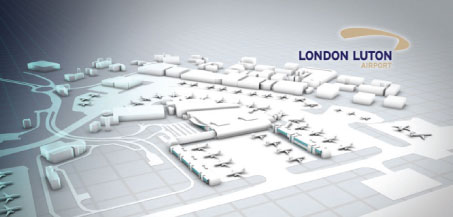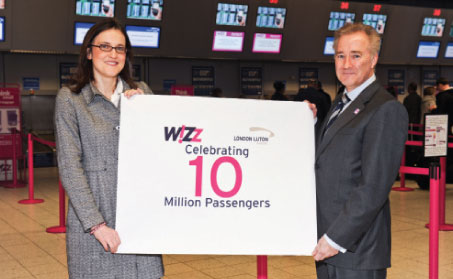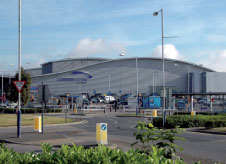
A series of sustainable developments are planned to enhance the passenger experience and provide additional capacity at London Luton – the aim being to ensure that it continues to play an important role as ‘London’s local airport’.
London Luton Airport Operations Limited (LLAOL) has a concession with London Luton Airport Limited (LLAL) – a company wholly owned by Luton Borough Council – to operate the airport on its behalf until 2031. A series of sustainable developments are planned to enhance the passenger experience and provide additional capacity – the aim being to ensure that London Luton continues to play an important role as what it describes as ‘London’s local airport’.
The airport handled 9.5 million passengers in 2011 and its vision is a bigger, better airport, fulfilling a crucial role in providing more, high quality capacity in the London airport system.
Glyn Jones, Managing Director, London Luton, said: “The Mayor of London has proposed a new hub in the Thames Estuary to deal with the constraints on medium and long haul aviation capacity in London and the South East. We have outlined a credible and realistic plan that, if approved, will put Luton at the heart of solving the burden on point-to-point short haul operators who want to grow.”

Then-Aviation Minister Theresa Villiers and Glyn Jones, Managing Director, London Luton, mark Wizz Air’s 10-millionth passenger through the airport in just seven years.
The airport has three key objectives, two of which are to make London Luton a ‘bigger’ and a ‘better’ airport. The three main components of the proposed initial development phase would include: Improvements to the terminal building through the construction of a new pier, and a new layout which can be achieved through minor extension works that won’t disrupt the running of the airport; extending the taxiway to increase the number of aircraft movements, creating new aircraft stands, and upgrading existing ones; and constructing two new traffic lanes to the south of ‘Airport Way’, leading into a newly created set down system in the Central Terminal Area, which will ease
congestion and manage growth in the future.
One of the most significant proposed improvements to the terminal building is a two-storey infill extension at the front of the building, which will provide around 5,300sqm of additional floor space. The works will enhance the existing terminal building by bringing together the various existing building elements into a single cohesive structure, forming a focal point within the Central Terminal Area. The single terminal structure will be a highly flexible facility designed to rationalise passenger flows and remove, where possible, the crossover of departing and arriving passengers.
The third objective is to be the ‘best neighbour’ possible and the airport recognises the importance of environmentally sustainable development. The Master Plan foresees an increase in access by public transport to more than 40% of passengers by 2017; a package of mitigation measures to minimise the airport’s noise impact; and an annual reduction in carbon emissions. Indeed, while the airport saw 8.9% growth in passenger numbers in 2011, it reduced carbon emissions by 3.1%.
“By delivering against these three objectives, we believe that London Luton Airport can fulfil its potential of being both bigger and better, for airlines, passengers and communities,” commented Jones. “By combining real scale, ease of use and fast access to the capital, this Master Plan aims over the next 19 years to establish London Luton Airport as truly London’s
local airport.”
Economic impact

Glyn Jones, Managing Director, London Luton: “We have outlined a credible and realistic plan that, if approved, will put Luton at the heart of solving the burden on point-to-point short haul operators who want to grow.”
London Luton already makes a significant contribution to the local economy. According to its figures, the airport has an annual economic impact of £780 million (€980m) – a figure forecast to increase to £998 million (€1.3bn) over the period covered in the Master Plan. The statistics relating to jobs are equally impressive. Direct employment is currently 8,200 jobs, which the airport believes will rise to 9,900. The proposed development will increase levels of direct and indirect employment associated with operation of the airport. Meanwhile, increased passenger throughput will boost the economic value of the airport to both the local and regional economy. The airport currently generates £187 million (€235m) in annual revenue for local and central government; that figure is forecast to grow by £65 million (€82m) to £252 million (€316m) over the course of the Master Plan.
Wizz Air’s Luton growth
Then-Aviation Minister Theresa Villiers recently visited the airport and joined celebrations for Wizz Air flying its 10-millionth passenger through London Luton in just seven years. Indeed, it was also recently announced that Wizz Air will add a seventh Polish destination – Lublin – from London Luton in December 2012.
Villiers commented: “We have been clear that we want aviation to be able to grow, and it is encouraging to see how successful London Luton Airport has become. London Luton is playing an increasingly important role in the aviation connectivity in London and the South East, as well as opening up new markets around the world to the local economy and providing employment for thousands of people.”
Meanwhile, Jones explained that the strong working partnership that the airport has forged with Wizz Air has secured an average annual growth in passengers of 39% over seven years, opening up new markets around the world to the local and regional economy. “Despite the challenging economic climate the low-cost model which we have developed here at the airport has allowed both London Luton and modern, dynamic airlines such as Wizz Air to become successful growth stories,” he said.
London Luton has ambitious plans, which will be achieved within the existing airport boundary and by making best use of the existing infrastructure.
Ultimately, the improvements outlined in the master plan will provide a significantly better terminal for passengers, as well as more efficient use of the runway and aircraft parking areas, to say nothing of the extra south-east UK capacity also being delivered.







